HR Practices: Skills, Learning, Performance in Primark (Module Report)
VerifiedAdded on 2020/07/23
|15
|4478
|34
Report
AI Summary
This report provides a comprehensive analysis of human resource practices within Primark, an Irish clothing and accessories company. It begins by outlining the essential knowledge, skills, and behaviors required of HR professionals, emphasizing the importance of managing people, resolving conflicts, and strategic planning. The report then includes a personal skill audit of an HR professional, Jane Cambridge, assessing her strengths and weaknesses to identify areas for development. Furthermore, it explores the differences between organizational and individual learning, training, and development, highlighting their roles in enhancing employee effectiveness and achieving business goals. The report also discusses the significance of high-performance work practices in gaining a competitive edge and examines various approaches to performance management, concluding with key insights into fostering individual, team, and organizational growth within Primark.
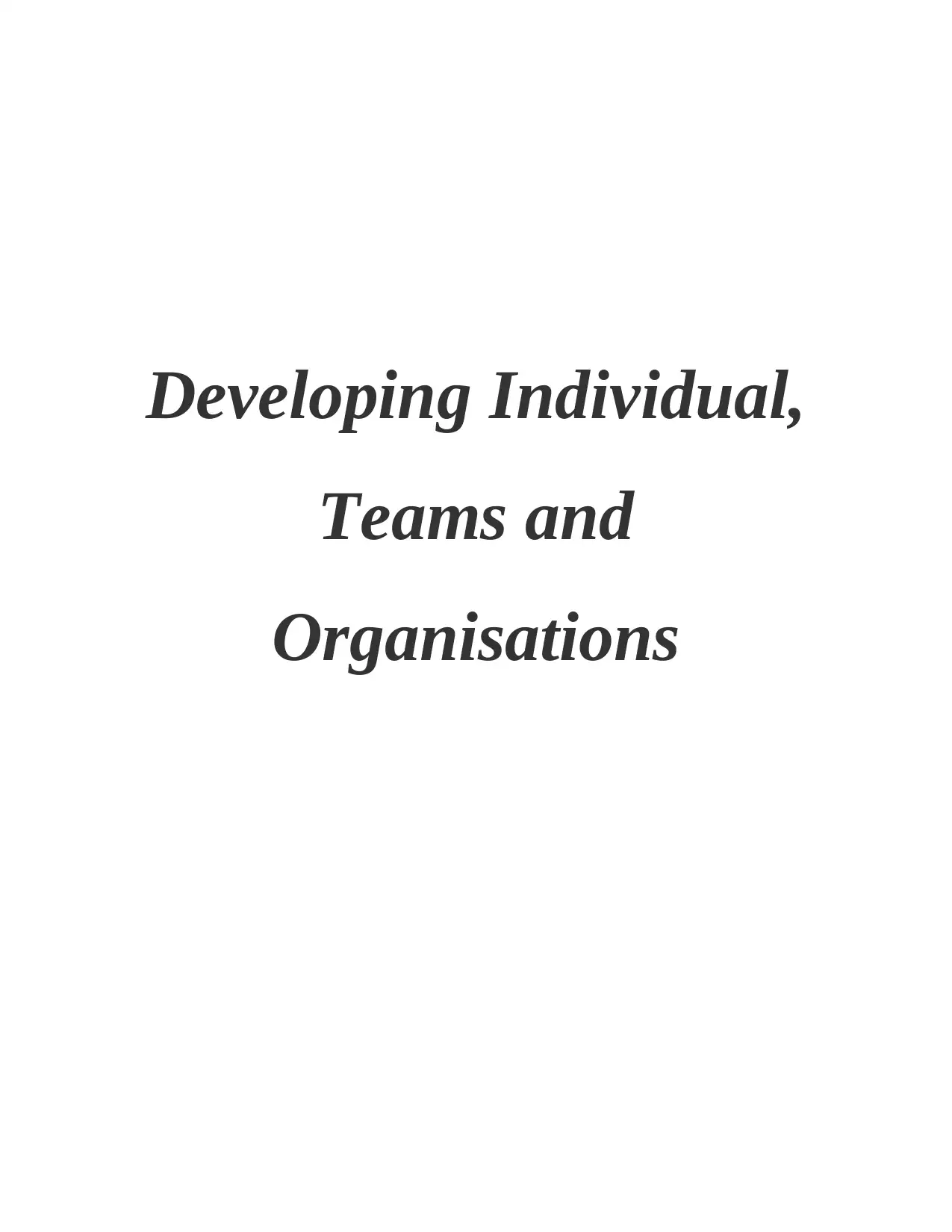
Developing Individual,
Teams and
Organisations
Teams and
Organisations
Paraphrase This Document
Need a fresh take? Get an instant paraphrase of this document with our AI Paraphraser
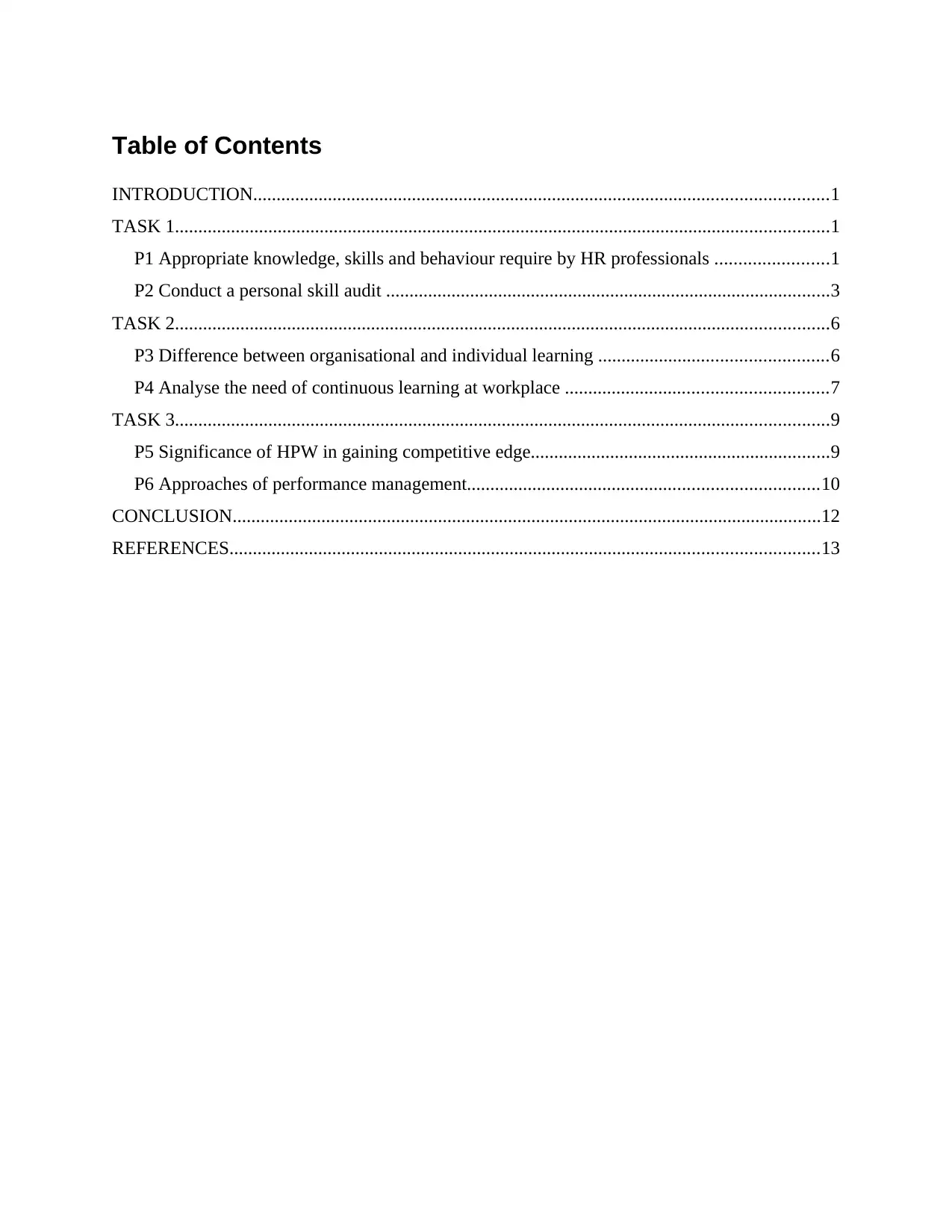
Table of Contents
INTRODUCTION...........................................................................................................................1
TASK 1............................................................................................................................................1
P1 Appropriate knowledge, skills and behaviour require by HR professionals ........................1
P2 Conduct a personal skill audit ...............................................................................................3
TASK 2............................................................................................................................................6
P3 Difference between organisational and individual learning .................................................6
P4 Analyse the need of continuous learning at workplace ........................................................7
TASK 3............................................................................................................................................9
P5 Significance of HPW in gaining competitive edge................................................................9
P6 Approaches of performance management...........................................................................10
CONCLUSION..............................................................................................................................12
REFERENCES..............................................................................................................................13
INTRODUCTION...........................................................................................................................1
TASK 1............................................................................................................................................1
P1 Appropriate knowledge, skills and behaviour require by HR professionals ........................1
P2 Conduct a personal skill audit ...............................................................................................3
TASK 2............................................................................................................................................6
P3 Difference between organisational and individual learning .................................................6
P4 Analyse the need of continuous learning at workplace ........................................................7
TASK 3............................................................................................................................................9
P5 Significance of HPW in gaining competitive edge................................................................9
P6 Approaches of performance management...........................................................................10
CONCLUSION..............................................................................................................................12
REFERENCES..............................................................................................................................13
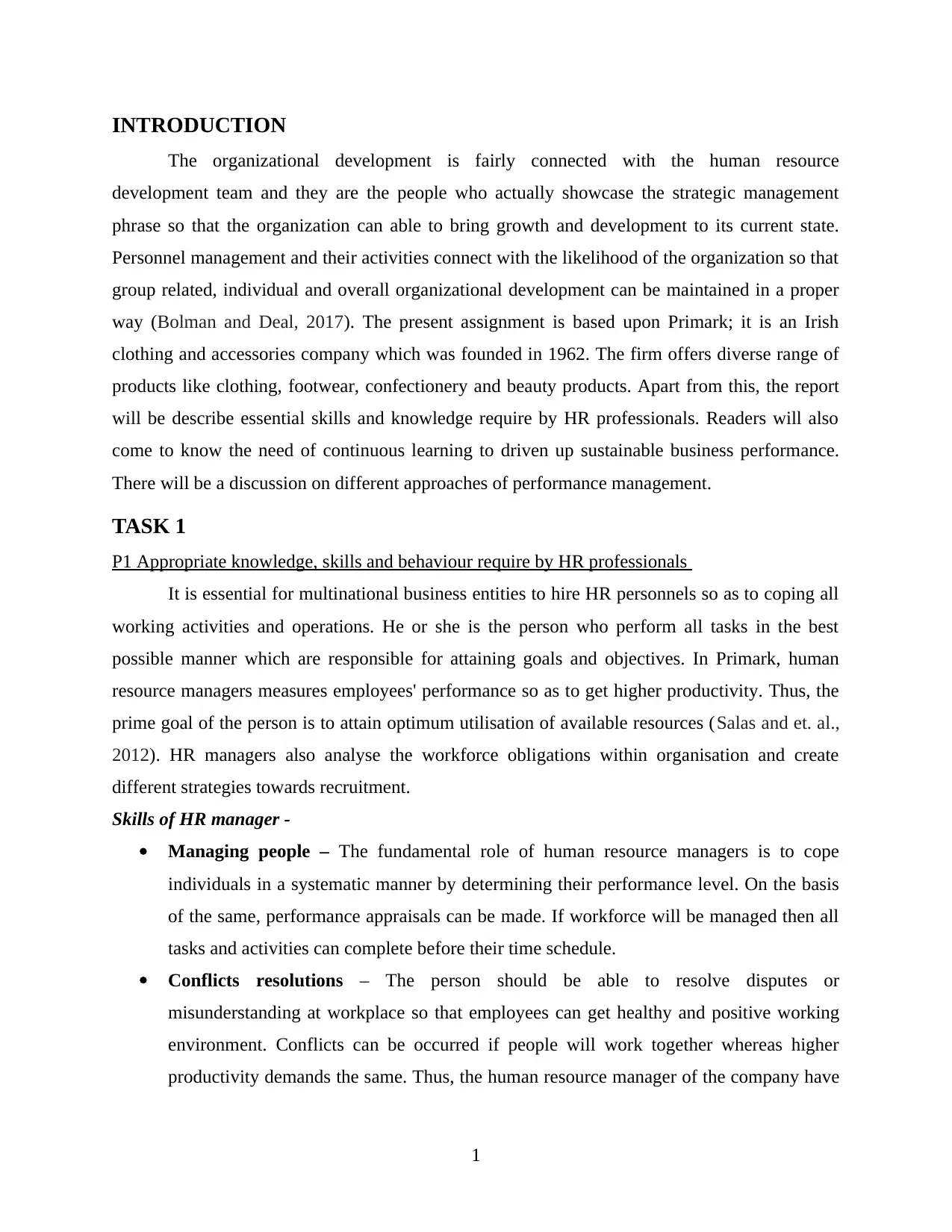
INTRODUCTION
The organizational development is fairly connected with the human resource
development team and they are the people who actually showcase the strategic management
phrase so that the organization can able to bring growth and development to its current state.
Personnel management and their activities connect with the likelihood of the organization so that
group related, individual and overall organizational development can be maintained in a proper
way (Bolman and Deal, 2017). The present assignment is based upon Primark; it is an Irish
clothing and accessories company which was founded in 1962. The firm offers diverse range of
products like clothing, footwear, confectionery and beauty products. Apart from this, the report
will be describe essential skills and knowledge require by HR professionals. Readers will also
come to know the need of continuous learning to driven up sustainable business performance.
There will be a discussion on different approaches of performance management.
TASK 1
P1 Appropriate knowledge, skills and behaviour require by HR professionals
It is essential for multinational business entities to hire HR personnels so as to coping all
working activities and operations. He or she is the person who perform all tasks in the best
possible manner which are responsible for attaining goals and objectives. In Primark, human
resource managers measures employees' performance so as to get higher productivity. Thus, the
prime goal of the person is to attain optimum utilisation of available resources (Salas and et. al.,
2012). HR managers also analyse the workforce obligations within organisation and create
different strategies towards recruitment.
Skills of HR manager -
Managing people – The fundamental role of human resource managers is to cope
individuals in a systematic manner by determining their performance level. On the basis
of the same, performance appraisals can be made. If workforce will be managed then all
tasks and activities can complete before their time schedule.
Conflicts resolutions – The person should be able to resolve disputes or
misunderstanding at workplace so that employees can get healthy and positive working
environment. Conflicts can be occurred if people will work together whereas higher
productivity demands the same. Thus, the human resource manager of the company have
1
The organizational development is fairly connected with the human resource
development team and they are the people who actually showcase the strategic management
phrase so that the organization can able to bring growth and development to its current state.
Personnel management and their activities connect with the likelihood of the organization so that
group related, individual and overall organizational development can be maintained in a proper
way (Bolman and Deal, 2017). The present assignment is based upon Primark; it is an Irish
clothing and accessories company which was founded in 1962. The firm offers diverse range of
products like clothing, footwear, confectionery and beauty products. Apart from this, the report
will be describe essential skills and knowledge require by HR professionals. Readers will also
come to know the need of continuous learning to driven up sustainable business performance.
There will be a discussion on different approaches of performance management.
TASK 1
P1 Appropriate knowledge, skills and behaviour require by HR professionals
It is essential for multinational business entities to hire HR personnels so as to coping all
working activities and operations. He or she is the person who perform all tasks in the best
possible manner which are responsible for attaining goals and objectives. In Primark, human
resource managers measures employees' performance so as to get higher productivity. Thus, the
prime goal of the person is to attain optimum utilisation of available resources (Salas and et. al.,
2012). HR managers also analyse the workforce obligations within organisation and create
different strategies towards recruitment.
Skills of HR manager -
Managing people – The fundamental role of human resource managers is to cope
individuals in a systematic manner by determining their performance level. On the basis
of the same, performance appraisals can be made. If workforce will be managed then all
tasks and activities can complete before their time schedule.
Conflicts resolutions – The person should be able to resolve disputes or
misunderstanding at workplace so that employees can get healthy and positive working
environment. Conflicts can be occurred if people will work together whereas higher
productivity demands the same. Thus, the human resource manager of the company have
1
⊘ This is a preview!⊘
Do you want full access?
Subscribe today to unlock all pages.

Trusted by 1+ million students worldwide
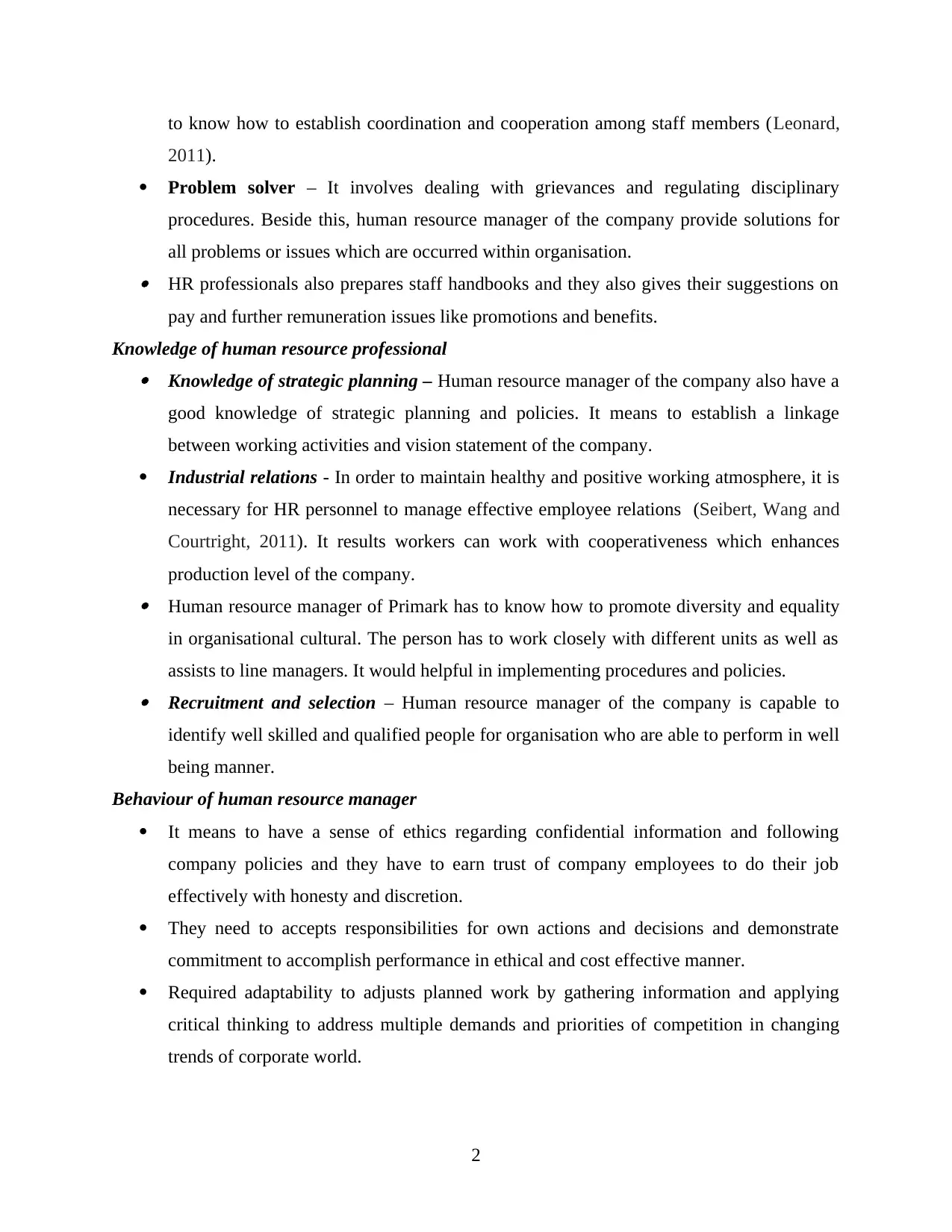
to know how to establish coordination and cooperation among staff members (Leonard,
2011).
Problem solver – It involves dealing with grievances and regulating disciplinary
procedures. Beside this, human resource manager of the company provide solutions for
all problems or issues which are occurred within organisation. HR professionals also prepares staff handbooks and they also gives their suggestions on
pay and further remuneration issues like promotions and benefits.
Knowledge of human resource professional Knowledge of strategic planning – Human resource manager of the company also have a
good knowledge of strategic planning and policies. It means to establish a linkage
between working activities and vision statement of the company.
Industrial relations - In order to maintain healthy and positive working atmosphere, it is
necessary for HR personnel to manage effective employee relations (Seibert, Wang and
Courtright, 2011). It results workers can work with cooperativeness which enhances
production level of the company. Human resource manager of Primark has to know how to promote diversity and equality
in organisational cultural. The person has to work closely with different units as well as
assists to line managers. It would helpful in implementing procedures and policies. Recruitment and selection – Human resource manager of the company is capable to
identify well skilled and qualified people for organisation who are able to perform in well
being manner.
Behaviour of human resource manager
It means to have a sense of ethics regarding confidential information and following
company policies and they have to earn trust of company employees to do their job
effectively with honesty and discretion.
They need to accepts responsibilities for own actions and decisions and demonstrate
commitment to accomplish performance in ethical and cost effective manner.
Required adaptability to adjusts planned work by gathering information and applying
critical thinking to address multiple demands and priorities of competition in changing
trends of corporate world.
2
2011).
Problem solver – It involves dealing with grievances and regulating disciplinary
procedures. Beside this, human resource manager of the company provide solutions for
all problems or issues which are occurred within organisation. HR professionals also prepares staff handbooks and they also gives their suggestions on
pay and further remuneration issues like promotions and benefits.
Knowledge of human resource professional Knowledge of strategic planning – Human resource manager of the company also have a
good knowledge of strategic planning and policies. It means to establish a linkage
between working activities and vision statement of the company.
Industrial relations - In order to maintain healthy and positive working atmosphere, it is
necessary for HR personnel to manage effective employee relations (Seibert, Wang and
Courtright, 2011). It results workers can work with cooperativeness which enhances
production level of the company. Human resource manager of Primark has to know how to promote diversity and equality
in organisational cultural. The person has to work closely with different units as well as
assists to line managers. It would helpful in implementing procedures and policies. Recruitment and selection – Human resource manager of the company is capable to
identify well skilled and qualified people for organisation who are able to perform in well
being manner.
Behaviour of human resource manager
It means to have a sense of ethics regarding confidential information and following
company policies and they have to earn trust of company employees to do their job
effectively with honesty and discretion.
They need to accepts responsibilities for own actions and decisions and demonstrate
commitment to accomplish performance in ethical and cost effective manner.
Required adaptability to adjusts planned work by gathering information and applying
critical thinking to address multiple demands and priorities of competition in changing
trends of corporate world.
2
Paraphrase This Document
Need a fresh take? Get an instant paraphrase of this document with our AI Paraphraser
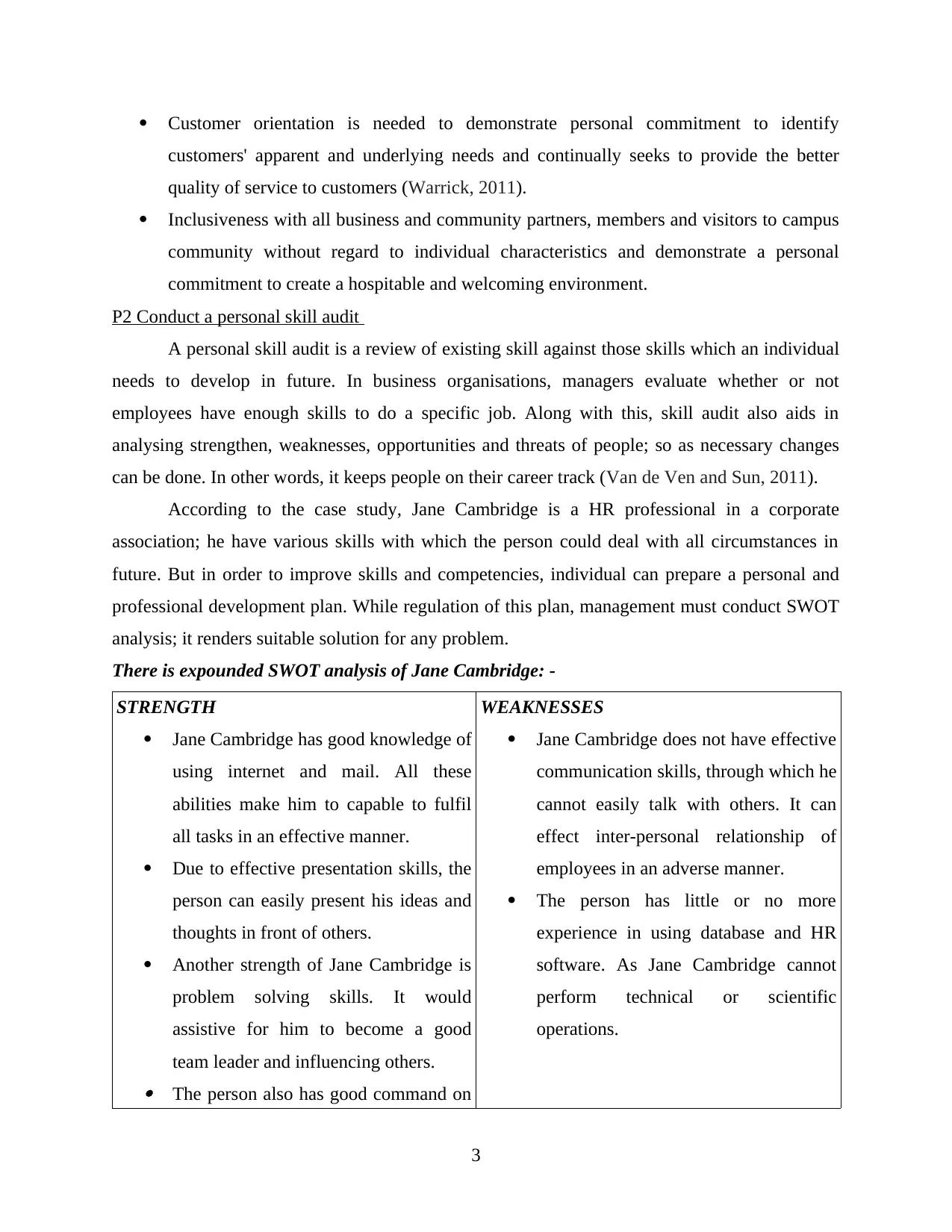
Customer orientation is needed to demonstrate personal commitment to identify
customers' apparent and underlying needs and continually seeks to provide the better
quality of service to customers (Warrick, 2011).
Inclusiveness with all business and community partners, members and visitors to campus
community without regard to individual characteristics and demonstrate a personal
commitment to create a hospitable and welcoming environment.
P2 Conduct a personal skill audit
A personal skill audit is a review of existing skill against those skills which an individual
needs to develop in future. In business organisations, managers evaluate whether or not
employees have enough skills to do a specific job. Along with this, skill audit also aids in
analysing strengthen, weaknesses, opportunities and threats of people; so as necessary changes
can be done. In other words, it keeps people on their career track (Van de Ven and Sun, 2011).
According to the case study, Jane Cambridge is a HR professional in a corporate
association; he have various skills with which the person could deal with all circumstances in
future. But in order to improve skills and competencies, individual can prepare a personal and
professional development plan. While regulation of this plan, management must conduct SWOT
analysis; it renders suitable solution for any problem.
There is expounded SWOT analysis of Jane Cambridge: -
STRENGTH
Jane Cambridge has good knowledge of
using internet and mail. All these
abilities make him to capable to fulfil
all tasks in an effective manner.
Due to effective presentation skills, the
person can easily present his ideas and
thoughts in front of others.
Another strength of Jane Cambridge is
problem solving skills. It would
assistive for him to become a good
team leader and influencing others. The person also has good command on
WEAKNESSES
Jane Cambridge does not have effective
communication skills, through which he
cannot easily talk with others. It can
effect inter-personal relationship of
employees in an adverse manner.
The person has little or no more
experience in using database and HR
software. As Jane Cambridge cannot
perform technical or scientific
operations.
3
customers' apparent and underlying needs and continually seeks to provide the better
quality of service to customers (Warrick, 2011).
Inclusiveness with all business and community partners, members and visitors to campus
community without regard to individual characteristics and demonstrate a personal
commitment to create a hospitable and welcoming environment.
P2 Conduct a personal skill audit
A personal skill audit is a review of existing skill against those skills which an individual
needs to develop in future. In business organisations, managers evaluate whether or not
employees have enough skills to do a specific job. Along with this, skill audit also aids in
analysing strengthen, weaknesses, opportunities and threats of people; so as necessary changes
can be done. In other words, it keeps people on their career track (Van de Ven and Sun, 2011).
According to the case study, Jane Cambridge is a HR professional in a corporate
association; he have various skills with which the person could deal with all circumstances in
future. But in order to improve skills and competencies, individual can prepare a personal and
professional development plan. While regulation of this plan, management must conduct SWOT
analysis; it renders suitable solution for any problem.
There is expounded SWOT analysis of Jane Cambridge: -
STRENGTH
Jane Cambridge has good knowledge of
using internet and mail. All these
abilities make him to capable to fulfil
all tasks in an effective manner.
Due to effective presentation skills, the
person can easily present his ideas and
thoughts in front of others.
Another strength of Jane Cambridge is
problem solving skills. It would
assistive for him to become a good
team leader and influencing others. The person also has good command on
WEAKNESSES
Jane Cambridge does not have effective
communication skills, through which he
cannot easily talk with others. It can
effect inter-personal relationship of
employees in an adverse manner.
The person has little or no more
experience in using database and HR
software. As Jane Cambridge cannot
perform technical or scientific
operations.
3
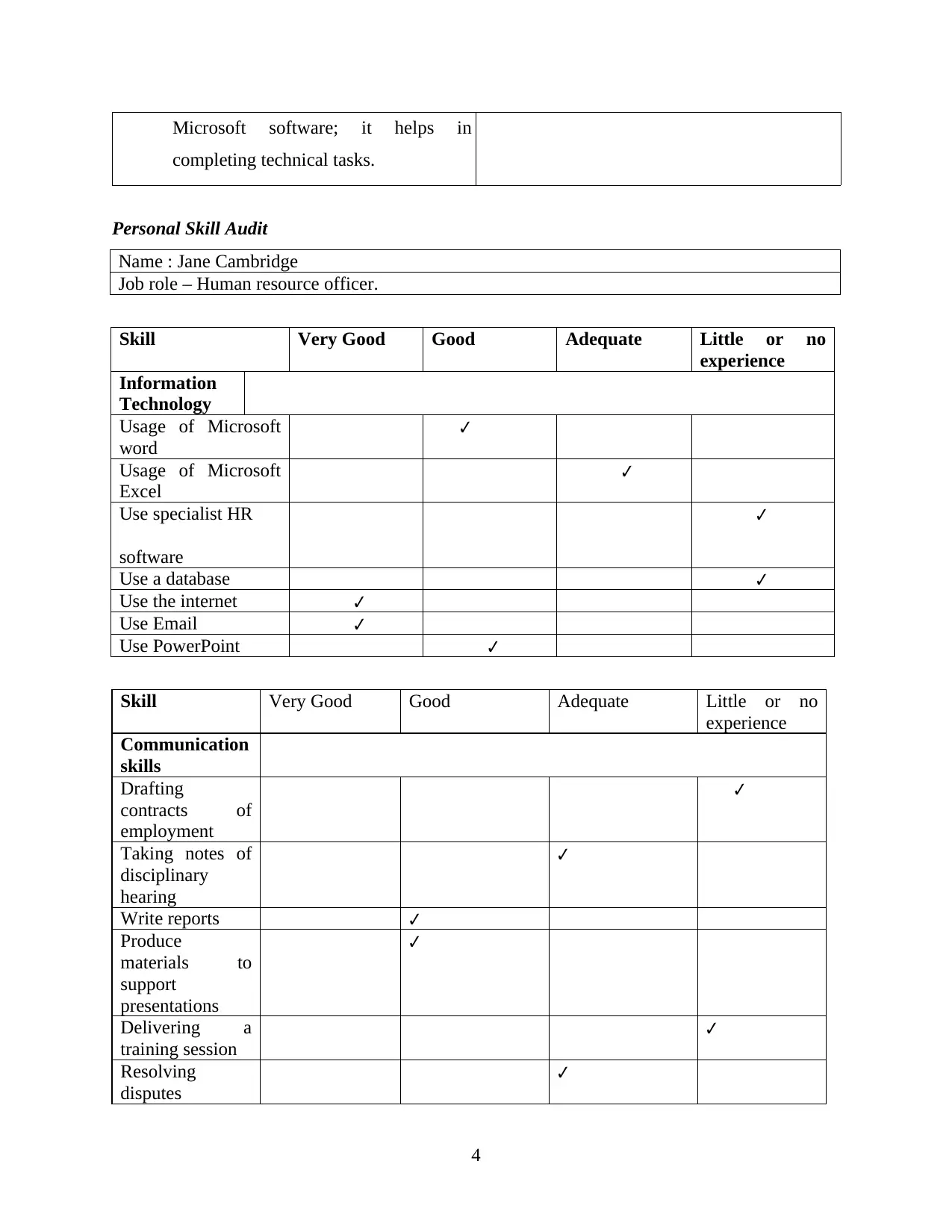
Microsoft software; it helps in
completing technical tasks.
Personal Skill Audit
Name : Jane Cambridge
Job role – Human resource officer.
Skill Very Good Good Adequate Little or no
experience
Information
Technology
Usage of Microsoft
word
✔
Usage of Microsoft
Excel
✔
Use specialist HR
software
✔
Use a database ✔
Use the internet ✔
Use Email ✔
Use PowerPoint ✔
Skill Very Good Good Adequate Little or no
experience
Communication
skills
Drafting
contracts of
employment
✔
Taking notes of
disciplinary
hearing
✔
Write reports ✔
Produce
materials to
support
presentations
✔
Delivering a
training session
✔
Resolving
disputes
✔
4
completing technical tasks.
Personal Skill Audit
Name : Jane Cambridge
Job role – Human resource officer.
Skill Very Good Good Adequate Little or no
experience
Information
Technology
Usage of Microsoft
word
✔
Usage of Microsoft
Excel
✔
Use specialist HR
software
✔
Use a database ✔
Use the internet ✔
Use Email ✔
Use PowerPoint ✔
Skill Very Good Good Adequate Little or no
experience
Communication
skills
Drafting
contracts of
employment
✔
Taking notes of
disciplinary
hearing
✔
Write reports ✔
Produce
materials to
support
presentations
✔
Delivering a
training session
✔
Resolving
disputes
✔
4
⊘ This is a preview!⊘
Do you want full access?
Subscribe today to unlock all pages.

Trusted by 1+ million students worldwide
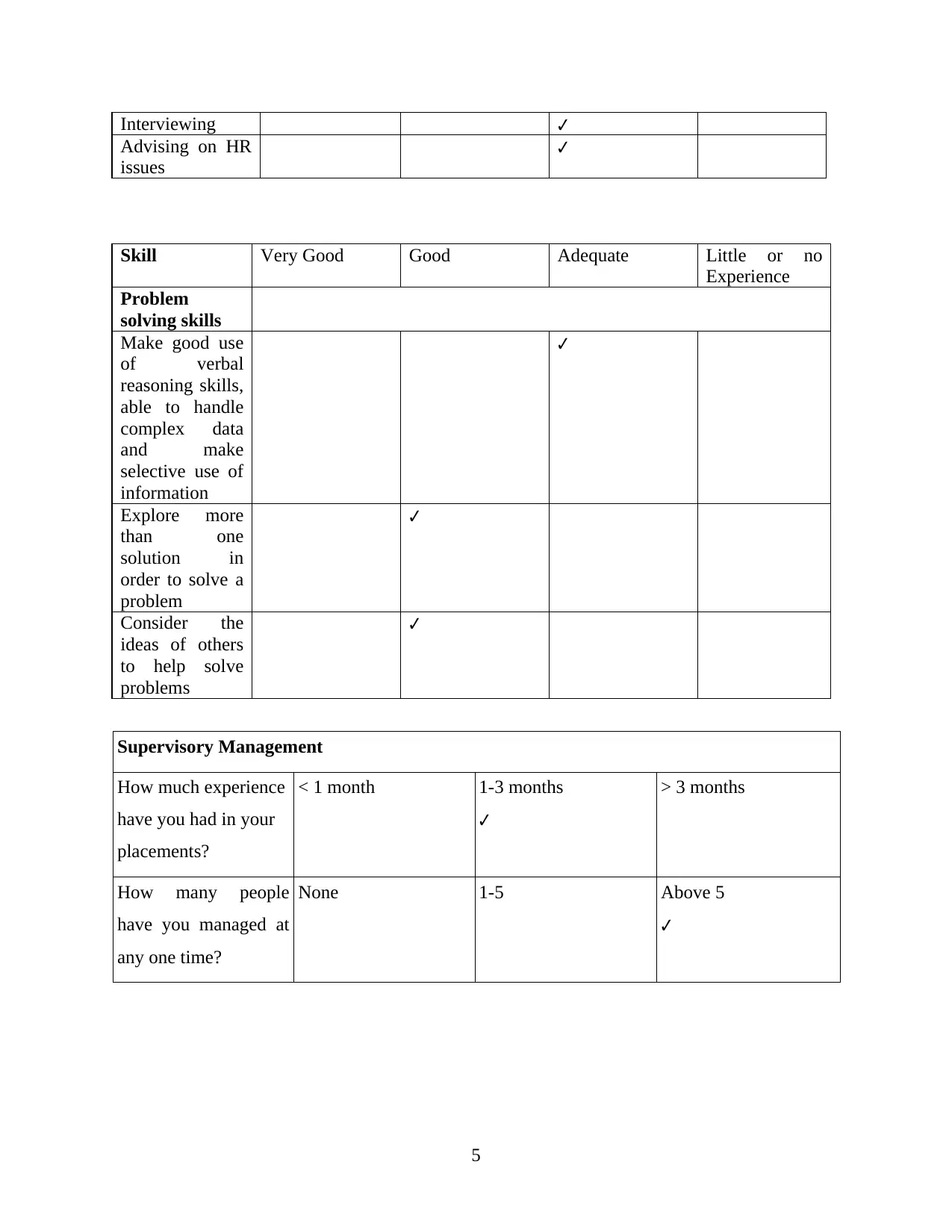
Interviewing ✔
Advising on HR
issues
✔
Skill Very Good Good Adequate Little or no
Experience
Problem
solving skills
Make good use
of verbal
reasoning skills,
able to handle
complex data
and make
selective use of
information
✔
Explore more
than one
solution in
order to solve a
problem
✔
Consider the
ideas of others
to help solve
problems
✔
Supervisory Management
How much experience
have you had in your
placements?
< 1 month 1-3 months
✔
> 3 months
How many people
have you managed at
any one time?
None 1-5 Above 5
✔
5
Advising on HR
issues
✔
Skill Very Good Good Adequate Little or no
Experience
Problem
solving skills
Make good use
of verbal
reasoning skills,
able to handle
complex data
and make
selective use of
information
✔
Explore more
than one
solution in
order to solve a
problem
✔
Consider the
ideas of others
to help solve
problems
✔
Supervisory Management
How much experience
have you had in your
placements?
< 1 month 1-3 months
✔
> 3 months
How many people
have you managed at
any one time?
None 1-5 Above 5
✔
5
Paraphrase This Document
Need a fresh take? Get an instant paraphrase of this document with our AI Paraphraser
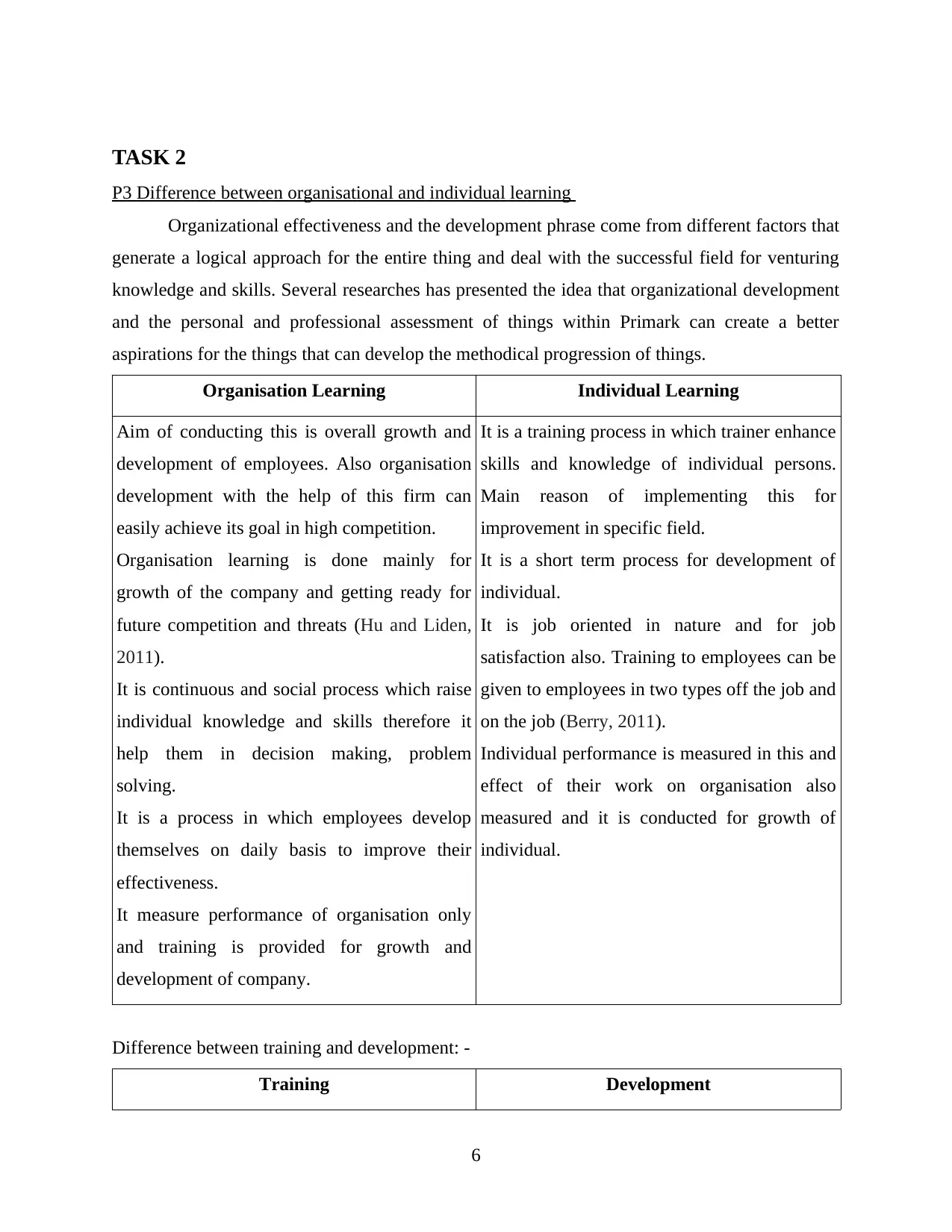
TASK 2
P3 Difference between organisational and individual learning
Organizational effectiveness and the development phrase come from different factors that
generate a logical approach for the entire thing and deal with the successful field for venturing
knowledge and skills. Several researches has presented the idea that organizational development
and the personal and professional assessment of things within Primark can create a better
aspirations for the things that can develop the methodical progression of things.
Organisation Learning Individual Learning
Aim of conducting this is overall growth and
development of employees. Also organisation
development with the help of this firm can
easily achieve its goal in high competition.
Organisation learning is done mainly for
growth of the company and getting ready for
future competition and threats (Hu and Liden,
2011).
It is continuous and social process which raise
individual knowledge and skills therefore it
help them in decision making, problem
solving.
It is a process in which employees develop
themselves on daily basis to improve their
effectiveness.
It measure performance of organisation only
and training is provided for growth and
development of company.
It is a training process in which trainer enhance
skills and knowledge of individual persons.
Main reason of implementing this for
improvement in specific field.
It is a short term process for development of
individual.
It is job oriented in nature and for job
satisfaction also. Training to employees can be
given to employees in two types off the job and
on the job (Berry, 2011).
Individual performance is measured in this and
effect of their work on organisation also
measured and it is conducted for growth of
individual.
Difference between training and development: -
Training Development
6
P3 Difference between organisational and individual learning
Organizational effectiveness and the development phrase come from different factors that
generate a logical approach for the entire thing and deal with the successful field for venturing
knowledge and skills. Several researches has presented the idea that organizational development
and the personal and professional assessment of things within Primark can create a better
aspirations for the things that can develop the methodical progression of things.
Organisation Learning Individual Learning
Aim of conducting this is overall growth and
development of employees. Also organisation
development with the help of this firm can
easily achieve its goal in high competition.
Organisation learning is done mainly for
growth of the company and getting ready for
future competition and threats (Hu and Liden,
2011).
It is continuous and social process which raise
individual knowledge and skills therefore it
help them in decision making, problem
solving.
It is a process in which employees develop
themselves on daily basis to improve their
effectiveness.
It measure performance of organisation only
and training is provided for growth and
development of company.
It is a training process in which trainer enhance
skills and knowledge of individual persons.
Main reason of implementing this for
improvement in specific field.
It is a short term process for development of
individual.
It is job oriented in nature and for job
satisfaction also. Training to employees can be
given to employees in two types off the job and
on the job (Berry, 2011).
Individual performance is measured in this and
effect of their work on organisation also
measured and it is conducted for growth of
individual.
Difference between training and development: -
Training Development
6
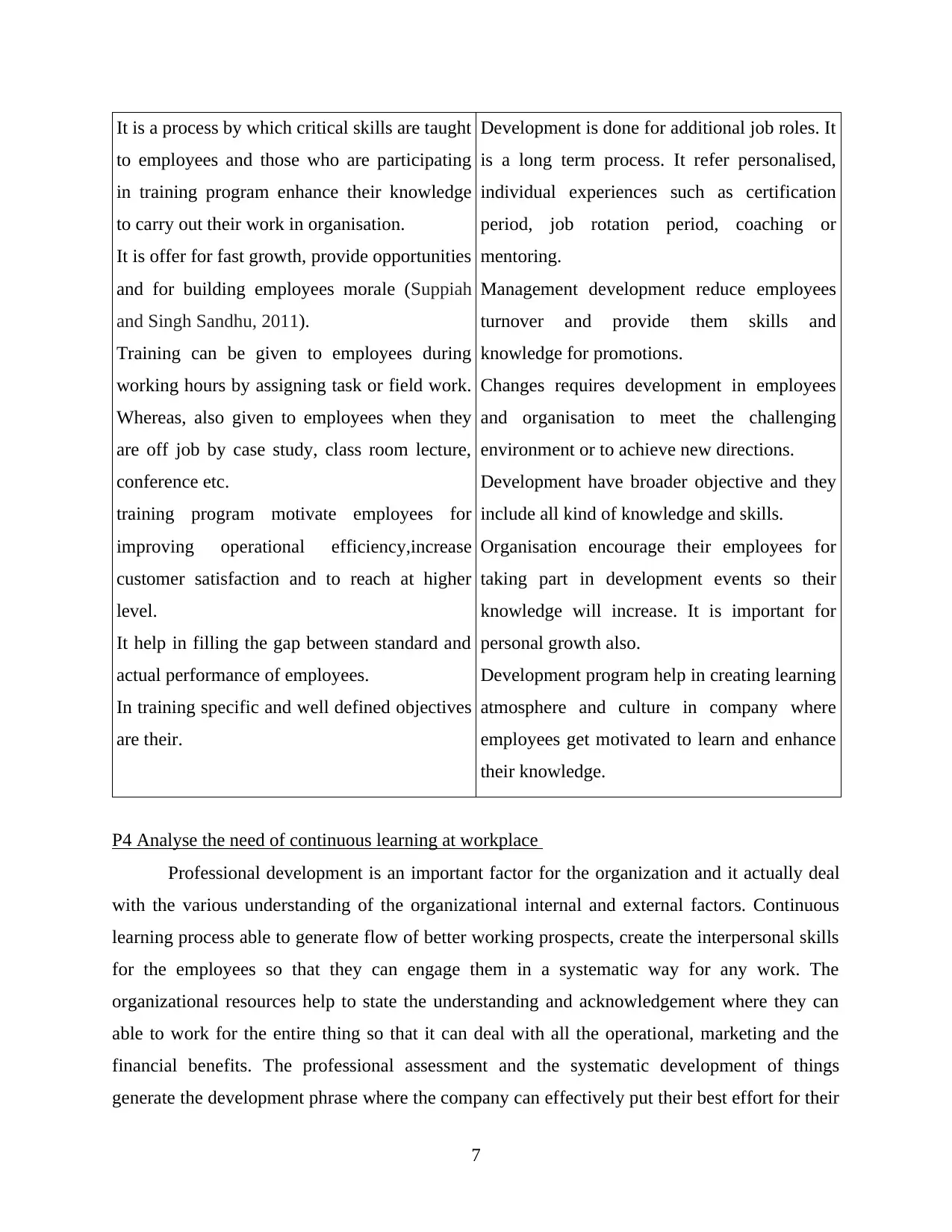
It is a process by which critical skills are taught
to employees and those who are participating
in training program enhance their knowledge
to carry out their work in organisation.
It is offer for fast growth, provide opportunities
and for building employees morale (Suppiah
and Singh Sandhu, 2011).
Training can be given to employees during
working hours by assigning task or field work.
Whereas, also given to employees when they
are off job by case study, class room lecture,
conference etc.
training program motivate employees for
improving operational efficiency,increase
customer satisfaction and to reach at higher
level.
It help in filling the gap between standard and
actual performance of employees.
In training specific and well defined objectives
are their.
Development is done for additional job roles. It
is a long term process. It refer personalised,
individual experiences such as certification
period, job rotation period, coaching or
mentoring.
Management development reduce employees
turnover and provide them skills and
knowledge for promotions.
Changes requires development in employees
and organisation to meet the challenging
environment or to achieve new directions.
Development have broader objective and they
include all kind of knowledge and skills.
Organisation encourage their employees for
taking part in development events so their
knowledge will increase. It is important for
personal growth also.
Development program help in creating learning
atmosphere and culture in company where
employees get motivated to learn and enhance
their knowledge.
P4 Analyse the need of continuous learning at workplace
Professional development is an important factor for the organization and it actually deal
with the various understanding of the organizational internal and external factors. Continuous
learning process able to generate flow of better working prospects, create the interpersonal skills
for the employees so that they can engage them in a systematic way for any work. The
organizational resources help to state the understanding and acknowledgement where they can
able to work for the entire thing so that it can deal with all the operational, marketing and the
financial benefits. The professional assessment and the systematic development of things
generate the development phrase where the company can effectively put their best effort for their
7
to employees and those who are participating
in training program enhance their knowledge
to carry out their work in organisation.
It is offer for fast growth, provide opportunities
and for building employees morale (Suppiah
and Singh Sandhu, 2011).
Training can be given to employees during
working hours by assigning task or field work.
Whereas, also given to employees when they
are off job by case study, class room lecture,
conference etc.
training program motivate employees for
improving operational efficiency,increase
customer satisfaction and to reach at higher
level.
It help in filling the gap between standard and
actual performance of employees.
In training specific and well defined objectives
are their.
Development is done for additional job roles. It
is a long term process. It refer personalised,
individual experiences such as certification
period, job rotation period, coaching or
mentoring.
Management development reduce employees
turnover and provide them skills and
knowledge for promotions.
Changes requires development in employees
and organisation to meet the challenging
environment or to achieve new directions.
Development have broader objective and they
include all kind of knowledge and skills.
Organisation encourage their employees for
taking part in development events so their
knowledge will increase. It is important for
personal growth also.
Development program help in creating learning
atmosphere and culture in company where
employees get motivated to learn and enhance
their knowledge.
P4 Analyse the need of continuous learning at workplace
Professional development is an important factor for the organization and it actually deal
with the various understanding of the organizational internal and external factors. Continuous
learning process able to generate flow of better working prospects, create the interpersonal skills
for the employees so that they can engage them in a systematic way for any work. The
organizational resources help to state the understanding and acknowledgement where they can
able to work for the entire thing so that it can deal with all the operational, marketing and the
financial benefits. The professional assessment and the systematic development of things
generate the development phrase where the company can effectively put their best effort for their
7
⊘ This is a preview!⊘
Do you want full access?
Subscribe today to unlock all pages.

Trusted by 1+ million students worldwide
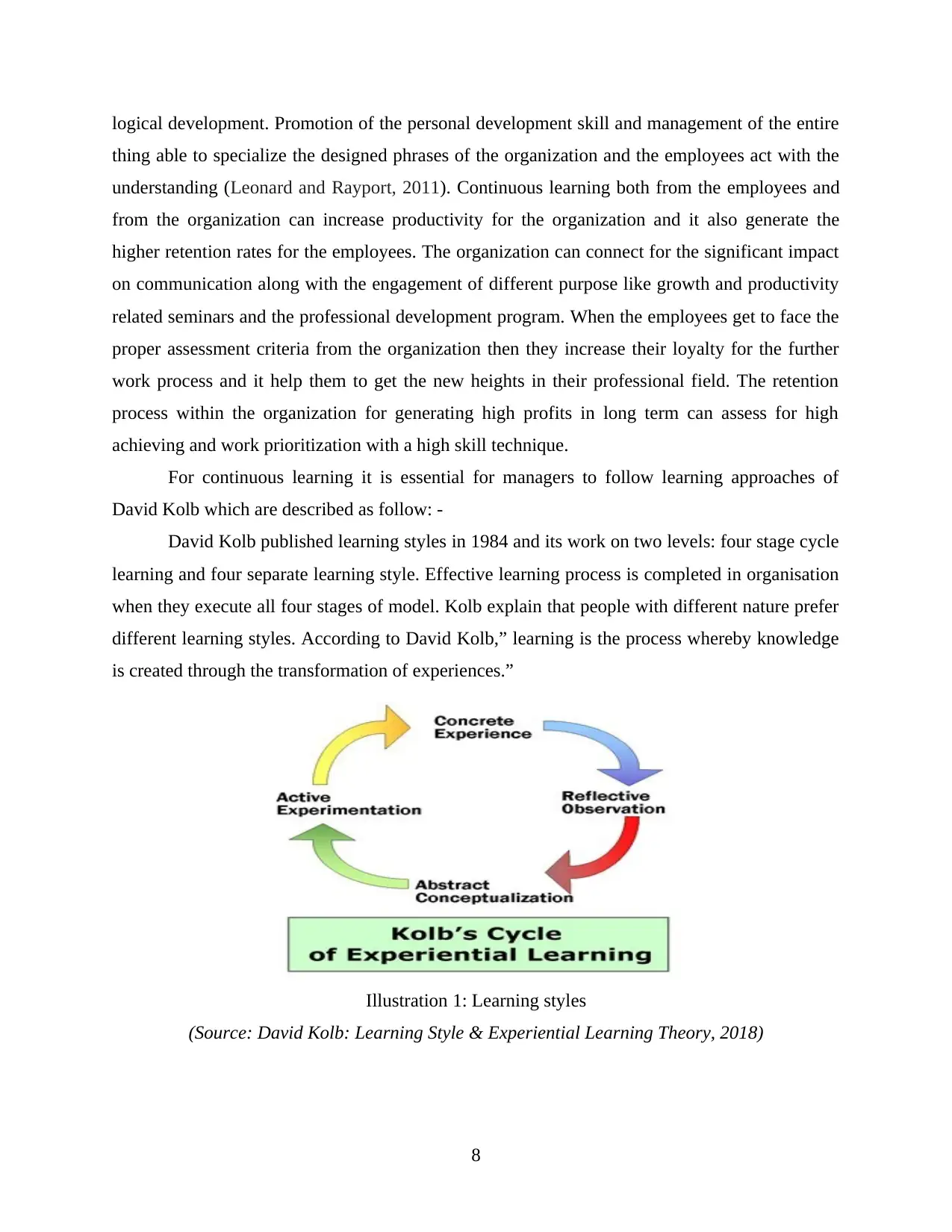
logical development. Promotion of the personal development skill and management of the entire
thing able to specialize the designed phrases of the organization and the employees act with the
understanding (Leonard and Rayport, 2011). Continuous learning both from the employees and
from the organization can increase productivity for the organization and it also generate the
higher retention rates for the employees. The organization can connect for the significant impact
on communication along with the engagement of different purpose like growth and productivity
related seminars and the professional development program. When the employees get to face the
proper assessment criteria from the organization then they increase their loyalty for the further
work process and it help them to get the new heights in their professional field. The retention
process within the organization for generating high profits in long term can assess for high
achieving and work prioritization with a high skill technique.
For continuous learning it is essential for managers to follow learning approaches of
David Kolb which are described as follow: -
David Kolb published learning styles in 1984 and its work on two levels: four stage cycle
learning and four separate learning style. Effective learning process is completed in organisation
when they execute all four stages of model. Kolb explain that people with different nature prefer
different learning styles. According to David Kolb,” learning is the process whereby knowledge
is created through the transformation of experiences.”
(Source: David Kolb: Learning Style & Experiential Learning Theory, 2018)
8
Illustration 1: Learning styles
thing able to specialize the designed phrases of the organization and the employees act with the
understanding (Leonard and Rayport, 2011). Continuous learning both from the employees and
from the organization can increase productivity for the organization and it also generate the
higher retention rates for the employees. The organization can connect for the significant impact
on communication along with the engagement of different purpose like growth and productivity
related seminars and the professional development program. When the employees get to face the
proper assessment criteria from the organization then they increase their loyalty for the further
work process and it help them to get the new heights in their professional field. The retention
process within the organization for generating high profits in long term can assess for high
achieving and work prioritization with a high skill technique.
For continuous learning it is essential for managers to follow learning approaches of
David Kolb which are described as follow: -
David Kolb published learning styles in 1984 and its work on two levels: four stage cycle
learning and four separate learning style. Effective learning process is completed in organisation
when they execute all four stages of model. Kolb explain that people with different nature prefer
different learning styles. According to David Kolb,” learning is the process whereby knowledge
is created through the transformation of experiences.”
(Source: David Kolb: Learning Style & Experiential Learning Theory, 2018)
8
Illustration 1: Learning styles
Paraphrase This Document
Need a fresh take? Get an instant paraphrase of this document with our AI Paraphraser
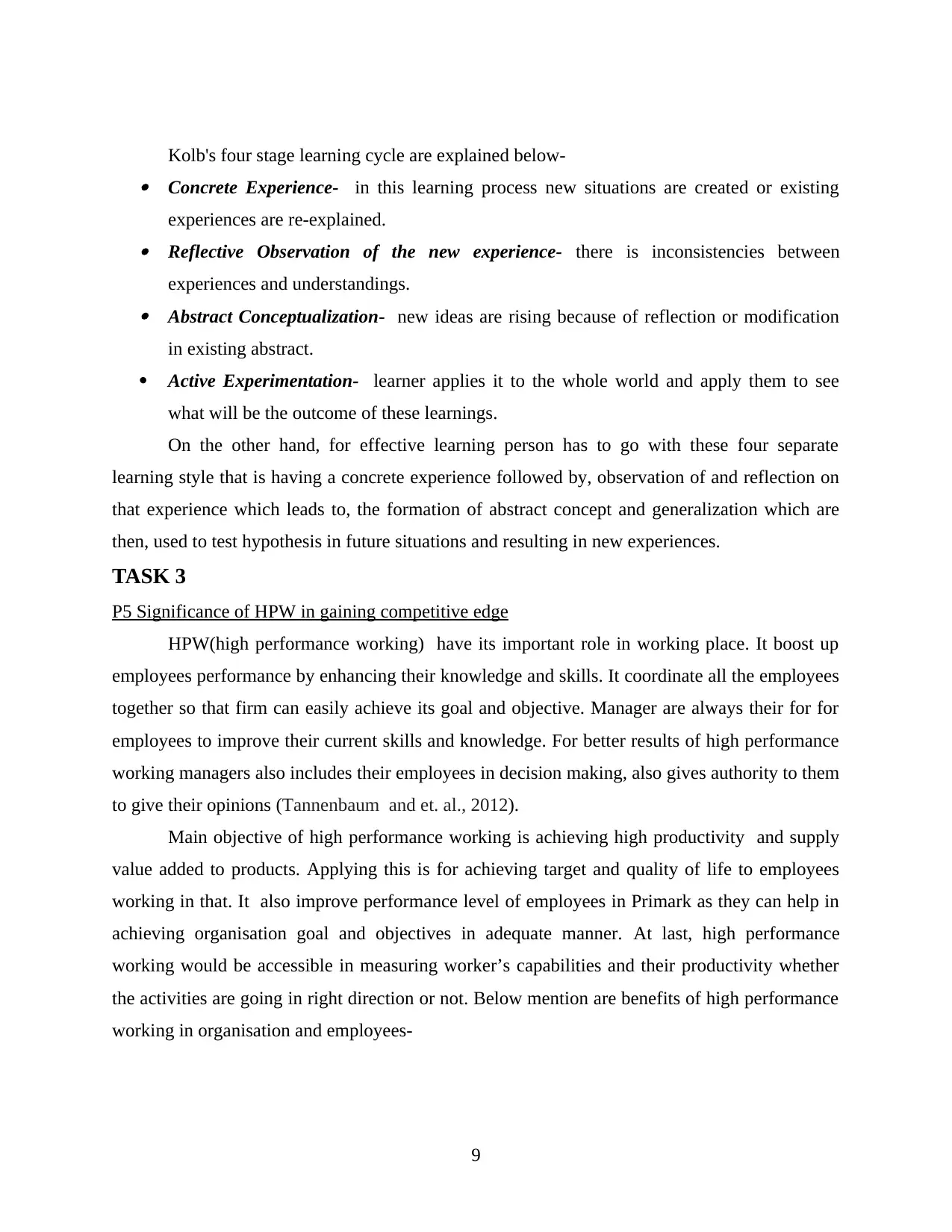
Kolb's four stage learning cycle are explained below- Concrete Experience- in this learning process new situations are created or existing
experiences are re-explained. Reflective Observation of the new experience- there is inconsistencies between
experiences and understandings. Abstract Conceptualization- new ideas are rising because of reflection or modification
in existing abstract.
Active Experimentation- learner applies it to the whole world and apply them to see
what will be the outcome of these learnings.
On the other hand, for effective learning person has to go with these four separate
learning style that is having a concrete experience followed by, observation of and reflection on
that experience which leads to, the formation of abstract concept and generalization which are
then, used to test hypothesis in future situations and resulting in new experiences.
TASK 3
P5 Significance of HPW in gaining competitive edge
HPW(high performance working) have its important role in working place. It boost up
employees performance by enhancing their knowledge and skills. It coordinate all the employees
together so that firm can easily achieve its goal and objective. Manager are always their for for
employees to improve their current skills and knowledge. For better results of high performance
working managers also includes their employees in decision making, also gives authority to them
to give their opinions (Tannenbaum and et. al., 2012).
Main objective of high performance working is achieving high productivity and supply
value added to products. Applying this is for achieving target and quality of life to employees
working in that. It also improve performance level of employees in Primark as they can help in
achieving organisation goal and objectives in adequate manner. At last, high performance
working would be accessible in measuring worker’s capabilities and their productivity whether
the activities are going in right direction or not. Below mention are benefits of high performance
working in organisation and employees-
9
experiences are re-explained. Reflective Observation of the new experience- there is inconsistencies between
experiences and understandings. Abstract Conceptualization- new ideas are rising because of reflection or modification
in existing abstract.
Active Experimentation- learner applies it to the whole world and apply them to see
what will be the outcome of these learnings.
On the other hand, for effective learning person has to go with these four separate
learning style that is having a concrete experience followed by, observation of and reflection on
that experience which leads to, the formation of abstract concept and generalization which are
then, used to test hypothesis in future situations and resulting in new experiences.
TASK 3
P5 Significance of HPW in gaining competitive edge
HPW(high performance working) have its important role in working place. It boost up
employees performance by enhancing their knowledge and skills. It coordinate all the employees
together so that firm can easily achieve its goal and objective. Manager are always their for for
employees to improve their current skills and knowledge. For better results of high performance
working managers also includes their employees in decision making, also gives authority to them
to give their opinions (Tannenbaum and et. al., 2012).
Main objective of high performance working is achieving high productivity and supply
value added to products. Applying this is for achieving target and quality of life to employees
working in that. It also improve performance level of employees in Primark as they can help in
achieving organisation goal and objectives in adequate manner. At last, high performance
working would be accessible in measuring worker’s capabilities and their productivity whether
the activities are going in right direction or not. Below mention are benefits of high performance
working in organisation and employees-
9
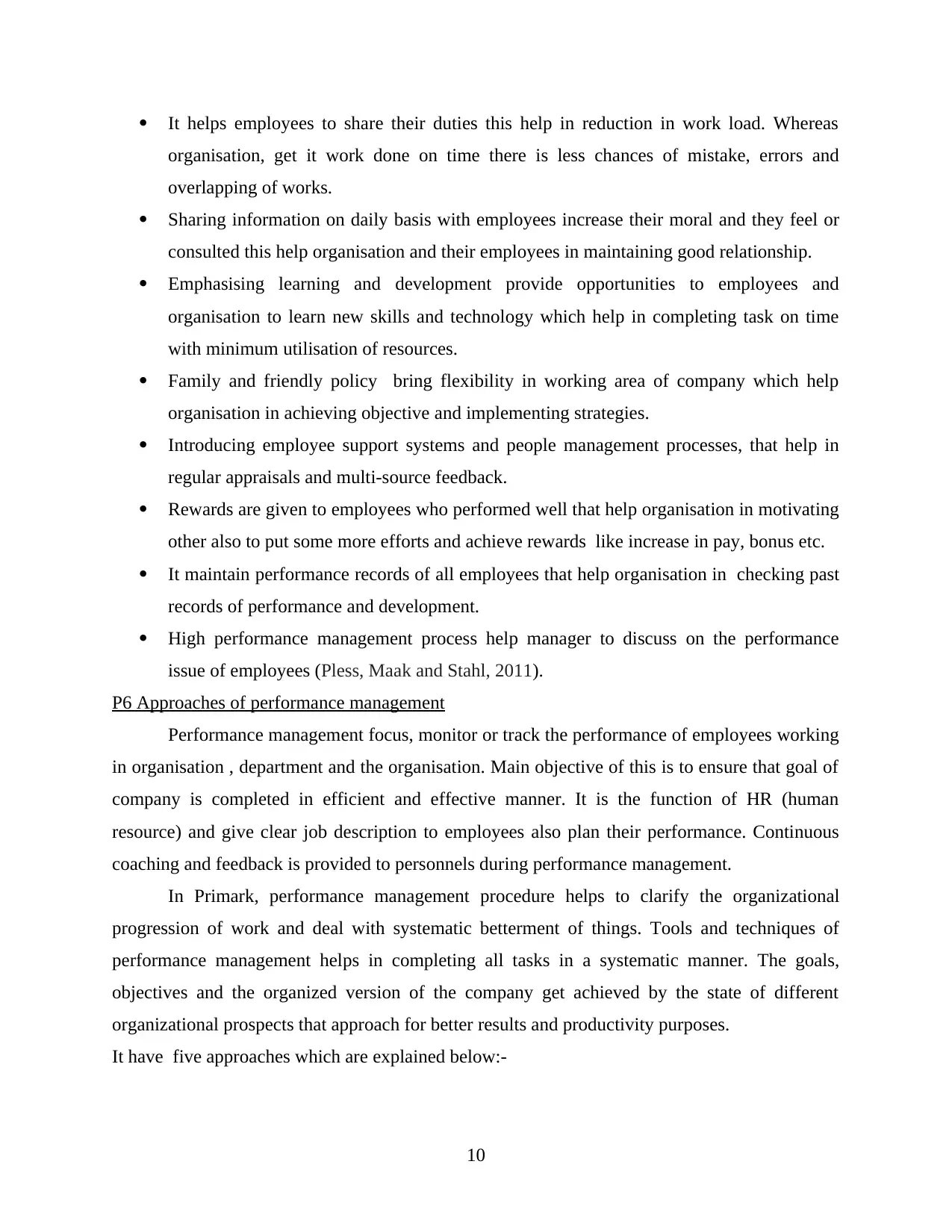
It helps employees to share their duties this help in reduction in work load. Whereas
organisation, get it work done on time there is less chances of mistake, errors and
overlapping of works.
Sharing information on daily basis with employees increase their moral and they feel or
consulted this help organisation and their employees in maintaining good relationship.
Emphasising learning and development provide opportunities to employees and
organisation to learn new skills and technology which help in completing task on time
with minimum utilisation of resources.
Family and friendly policy bring flexibility in working area of company which help
organisation in achieving objective and implementing strategies.
Introducing employee support systems and people management processes, that help in
regular appraisals and multi-source feedback.
Rewards are given to employees who performed well that help organisation in motivating
other also to put some more efforts and achieve rewards like increase in pay, bonus etc.
It maintain performance records of all employees that help organisation in checking past
records of performance and development.
High performance management process help manager to discuss on the performance
issue of employees (Pless, Maak and Stahl, 2011).
P6 Approaches of performance management
Performance management focus, monitor or track the performance of employees working
in organisation , department and the organisation. Main objective of this is to ensure that goal of
company is completed in efficient and effective manner. It is the function of HR (human
resource) and give clear job description to employees also plan their performance. Continuous
coaching and feedback is provided to personnels during performance management.
In Primark, performance management procedure helps to clarify the organizational
progression of work and deal with systematic betterment of things. Tools and techniques of
performance management helps in completing all tasks in a systematic manner. The goals,
objectives and the organized version of the company get achieved by the state of different
organizational prospects that approach for better results and productivity purposes.
It have five approaches which are explained below:-
10
organisation, get it work done on time there is less chances of mistake, errors and
overlapping of works.
Sharing information on daily basis with employees increase their moral and they feel or
consulted this help organisation and their employees in maintaining good relationship.
Emphasising learning and development provide opportunities to employees and
organisation to learn new skills and technology which help in completing task on time
with minimum utilisation of resources.
Family and friendly policy bring flexibility in working area of company which help
organisation in achieving objective and implementing strategies.
Introducing employee support systems and people management processes, that help in
regular appraisals and multi-source feedback.
Rewards are given to employees who performed well that help organisation in motivating
other also to put some more efforts and achieve rewards like increase in pay, bonus etc.
It maintain performance records of all employees that help organisation in checking past
records of performance and development.
High performance management process help manager to discuss on the performance
issue of employees (Pless, Maak and Stahl, 2011).
P6 Approaches of performance management
Performance management focus, monitor or track the performance of employees working
in organisation , department and the organisation. Main objective of this is to ensure that goal of
company is completed in efficient and effective manner. It is the function of HR (human
resource) and give clear job description to employees also plan their performance. Continuous
coaching and feedback is provided to personnels during performance management.
In Primark, performance management procedure helps to clarify the organizational
progression of work and deal with systematic betterment of things. Tools and techniques of
performance management helps in completing all tasks in a systematic manner. The goals,
objectives and the organized version of the company get achieved by the state of different
organizational prospects that approach for better results and productivity purposes.
It have five approaches which are explained below:-
10
⊘ This is a preview!⊘
Do you want full access?
Subscribe today to unlock all pages.

Trusted by 1+ million students worldwide
1 out of 15
Related Documents
Your All-in-One AI-Powered Toolkit for Academic Success.
+13062052269
info@desklib.com
Available 24*7 on WhatsApp / Email
![[object Object]](/_next/static/media/star-bottom.7253800d.svg)
Unlock your academic potential
Copyright © 2020–2025 A2Z Services. All Rights Reserved. Developed and managed by ZUCOL.




